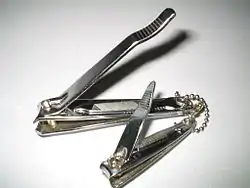爪切り
Japanese

| Kanji in this term | |
|---|---|
| 爪 | 切 |
| つめ Grade: S |
き Grade: 2 |
| kun’yomi | |
| Alternative spelling |
|---|
| 爪切 |
Etymology
Compound of 爪 (tsume, “nails, claws”) + 切り (kiri, “cutting, cutter”, stem of verb 切る, kiru, “to cut”).[1][2]
Pronunciation
Descendants
- Korean: 쓰메끼리 (sseumekkiri)
References
- Shōgaku Tosho (1988) 国語大辞典(新装版) [Unabridged Dictionary of Japanese (Revised Edition)] (in Japanese), Tōkyō: Shogakukan, →ISBN
- Matsumura, Akira, editor (2006), 大辞林 [Daijirin] (in Japanese), Third edition, Tōkyō: Sanseidō, →ISBN
- Kindaichi, Kyōsuke et al., editors (1997), 新明解国語辞典 [Shin Meikai Kokugo Jiten] (in Japanese), Fifth edition, Tōkyō: Sanseidō, →ISBN
- NHK Broadcasting Culture Research Institute, editor (1998), NHK日本語発音アクセント辞典 [NHK Japanese Pronunciation Accent Dictionary] (in Japanese), Tōkyō: NHK Publishing, →ISBN
This article is issued from Wiktionary. The text is licensed under Creative Commons - Attribution - Sharealike. Additional terms may apply for the media files.